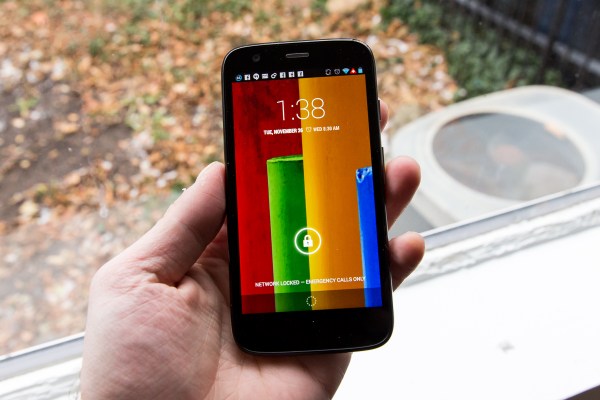Motorola has done its best to deliver a premium experience with an affordable price tag with the Moto G, the little sibling to the higher priced Moto X. Both phones have Google’s stamp all over them, and share a surprising amount in common besides that, too. Best of all, the Moto G is a phone that mostly delivers on its marketing premise, offering an experience that’ll have many doing a double take at that price tag.
Basics
- 4.5-inch, 1280×720, 326ppi display
- 8 or 16GB storage
- 5MP rear camera, 1.3MP front-facing
- 802.11n Wi-Fi
- Pentaband HSDPA support
- Bluetooth 4.0
- MSRP: $179/$199 unlocked, off-contract
- Product info page
Pros
- Price
- Amazing price
- You cannot buy a better phone at this price
Cons
- Max value, but still cuts some corners
Design
Motorola’s Moto G is a little on the pudgy side, but it feels at once comfortable and familiar. The matte finish back cases are great for grip, (though terrible for showing wear, as you can see from the photos), and it almost reminds me of the design of the iPhone 3G and 3GS. It also feels heavier than most modern superphones, but only just, and the weight isn’t necessarily a problem, as it adds a feeling of resilience to the Moto G. In many ways, the Moto G’s design harkens back to an era where phones were phones and meant business, and I found myself enjoying that impression.
[gallery ids="920229,920231,920230,920228,920227,920226"]
The one big problem with the design is the mechanism for removing the “removable” back case. You essentially dig in at the spot where the case breaks for the micro USB port, and then pull. Hard. Too hard. My fingers are tender from switching the device between case types, and I really felt I had to go beyond the point of what you could reasonably expect an average consumer to be comfortable with. Still, I honestly don’t think most people will care about switching the backplates beyond maybe doing it once.
Features
The Moto G has a number of unique features, though most of the development of the phone was based on stripping out the inessential and making a phone that just performs well despite a lower cost to build. There’s Moto Care, for instance, which offers instant access to tech support from Motorola staff via instant message or phone; Assist, which offers special modes for Driving, Meeting and Sleeping that change your phone’s behavior with one tap to suit different contexts; and Motorola Migrate, for bringing your old settings, text messages, call history, media and more with you when switching devices.
These features are excellent compared to most glommed on by Android OEMs, if only for the fact that you wouldn’t even know they were there unless you were actively seeking them out. The service app is a genius move considering the audience is likely to be people new to smartphones or advanced mobile devices, and the Assist function is a very handy shortcut for what’s often an arduous series of steps. Migrate isn’t something I got the chance to try out, but it definitely sounds like a value-add for people jumping on the Android bandwagon for the first time.
Performance
The Moto G isn’t a $600 superphone, but the times you’re aware of that while using it are surprisingly rare. It moves around the OS smoothly and quickly, for instance. Likewise, it quickly calls up Google Now and delivers speech recognition with the same accuracy and speed as its more expensive cousins. The only place I noticed some lag and slowdown was in the browser, where image-heavy content can cause some stuttering, but only in extreme cases: even photo heavy tumblrs, which are otherwise pretty sleek, behaved well.
The camera on the Moto G isn’t wonderful, but it’s fine for general use, and much better than you’ll find on most other budget smartphones. In a device like this, what I’m expecting from a camera is a workmanlike charm, and that’s what Motorola delivers. It’s a phone where you have to continually call to mind that absurdly low price tag – and when you do that, the photos the Moto G takes look plenty good.
Display

Motorola has done a terrific job with the Moto G’s screen, which is saying a lot coming from me. I’ve never liked how Moto tunes their screens – too contrasty, too saturated for my eye. But this time they haven’t gone overboard in that regard, and they’ve even managed to achieve the same high bar for pixel density that Apple does with its iPhone 5s (326ppi for those paying attention). It’s not full HD, the clarion call of the current crop of Android superphones, but it’s a far sight better than anything even in the same ballpark pricewise, and at any rate, text and images are still going to appear stunningly crisp on that screen.
Again, it still goes a little too hard on the color saturation and the excessive contrast, but it’s a big improvement for Motorola devices in general, and a true feat on a device at this price.
Battery
The Moto G earns its stripes with the battery, leaving aside its other nice attributes. It’s got “all day” life, according to Motorola, and that can translate to a lot depending on your usage patterns. I found that with light usage, I was getting around three days out of a single charge on average, which, in the age of smartphones, is just crazy.
The battery life on the Moto G makes it a great candidate for a “throw it in a bag, forget about it until you travel” phone, since in low power mode it can stretch its standby life to around a week. Under heavier use it returns to the realm of results achieved by other devices (but still beats most of them) and will definitely get you through the day. But again, in a budget phone, to have this kind of battery power is amazing.
Bottom Line
The Moto G is remarkable device. It’s arguably the less talented sibling of the flash-bang Moto X released by the Google-owned smartphone maker earlier this year, but it’s more noteworthy because it offers so much at such a stunning price point. Make no mistake: I’ll still be going back to a top tier device as my everyday phone of choice, but if I didn’t prioritize tech in my personal budget, or if I didn’t have the means, I’d be more than happy to use the Moto G day in and day out as my daily driver.
